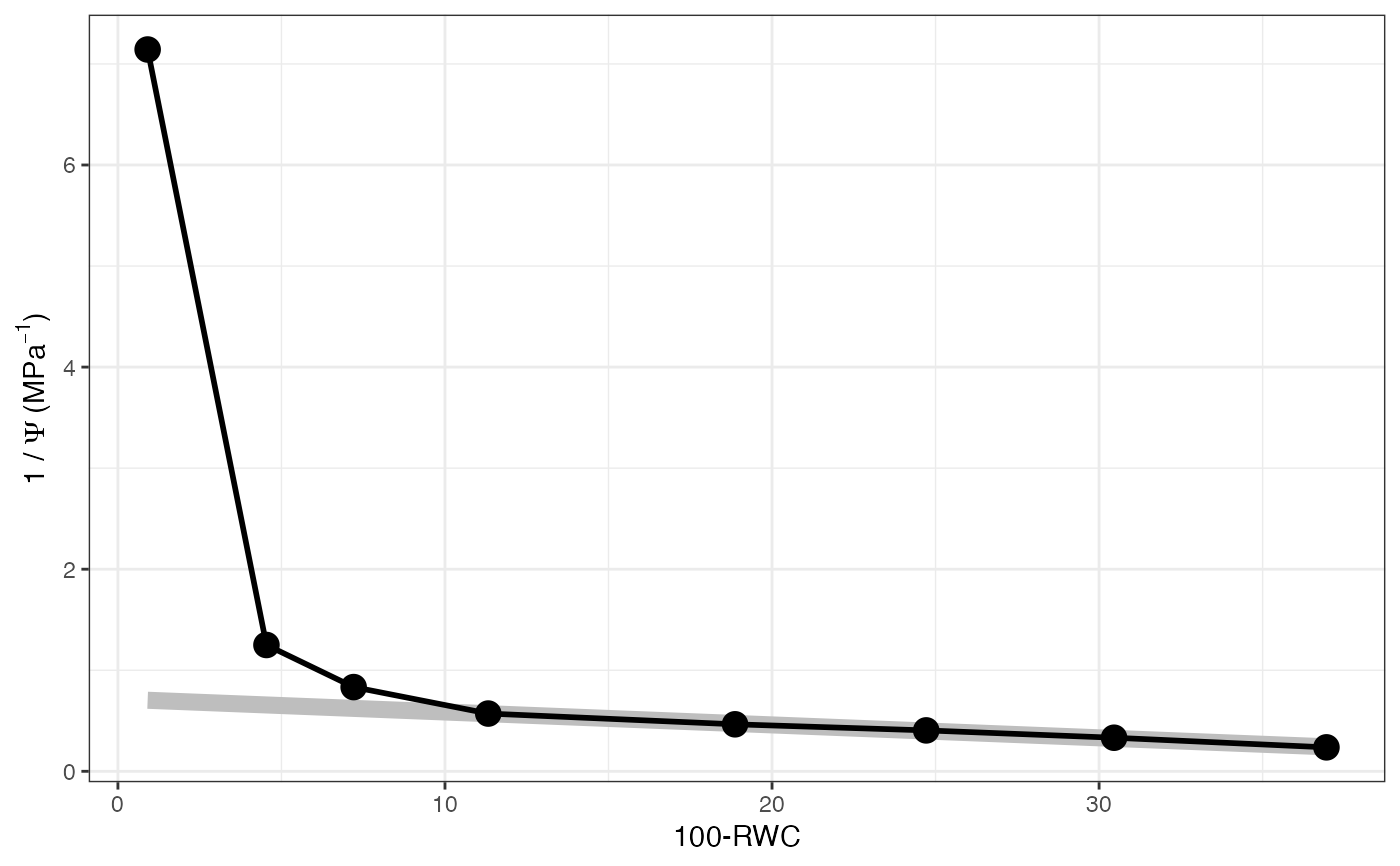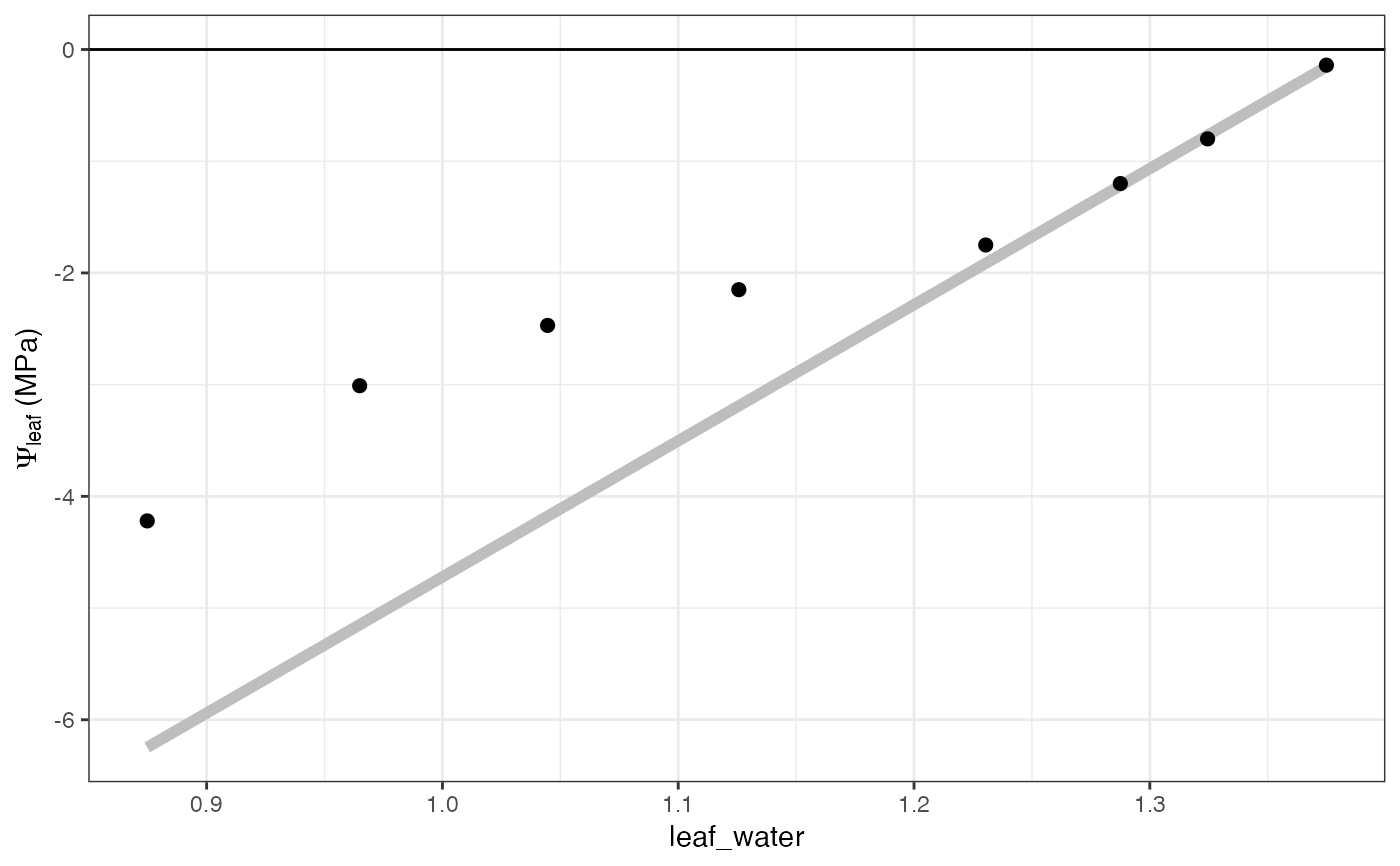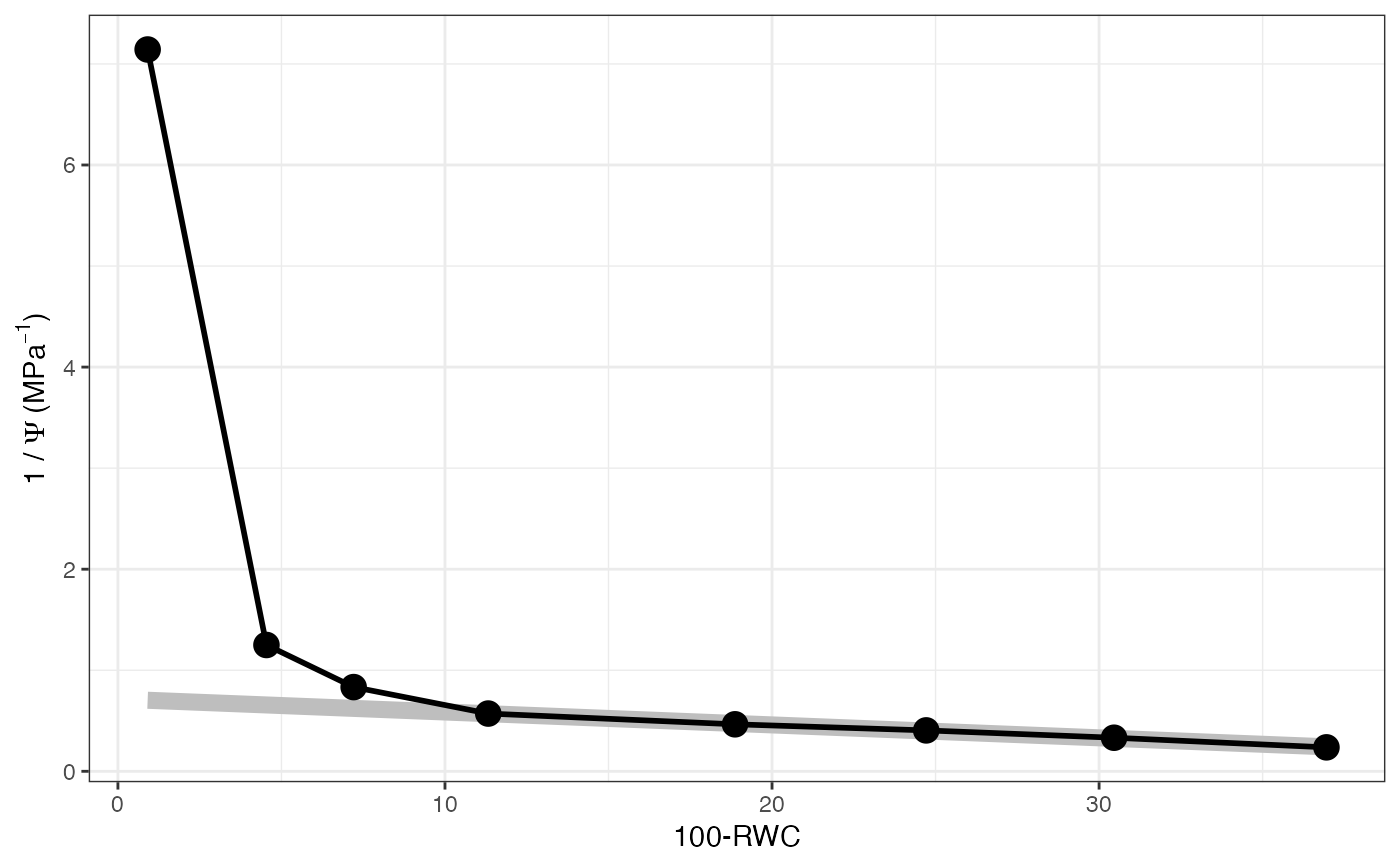Fitting pressure-volume curves
Usage
fit_PV_curve(
data,
varnames = list(psi = "psi", mass = "mass", leaf_mass = "leaf_mass", bag_mass =
"bag_mass", leaf_area = "leaf_area"),
title = NULL
)Arguments
- data
Dataframe
- varnames
Variable names. varnames = list(psi = "psi", mass = "mass", leaf_mass = "leaf_mass", bag_mass = "bag_mass", leaf_area = "leaf_area") where psi is leaf water potential in MPa, mass is the weighed mass of the bag and leaf in g, leaf_mass is the mass of the leaf in g, bag_mass is the mass of the bag in g, and leaf_area is the area of the leaf in cm2.
- title
Graph title
Value
fit_PV_curve fits pressure-volume curve data to determine: SWC: saturated water content per leaf mass (g H2O g leaf dry mass ^ -1), PI_o: osmotic potential at full turgor (MPa), psi_TLP: leaf water potential at turgor loss point (TLP) (MPa), RWC_TLP: relative water content at TLP (%), eps: modulus of elasticity at full turgor (MPa), C_FT: relative capacitance at full turgor (MPa ^ -1), C_TLP: relative capacitance at TLP (MPa ^ -1), and C_FTStar: absolute capacitance per leaf area (g m ^ -2 MPa ^ -1). Element 1 of the output list contains the fitted parameters, element 2 contains the water-psi graph, and element 3 contains the 1/psi-100-RWC graph.
References
Koide RT, Robichaux RH, Morse SR, Smith CM. 2000. Plant water status, hydraulic resistance and capacitance. In: Plant Physiological Ecology: Field Methods and Instrumentation (eds RW Pearcy, JR Ehleringer, HA Mooney, PW Rundel), pp. 161-183. Kluwer, Dordrecht, the Netherlands
Sack L, Cowan PD, Jaikumar N, Holbrook NM. 2003. The 'hydrology' of leaves: co-ordination of structure and function in temperate woody species. Plant, Cell and Environment, 26, 1343-1356
Tyree MT, Hammel HT. 1972. Measurement of turgor pressure and water relations of plants by pressure bomb technique. Journal of Experimental Botany, 23, 267
Examples
# \donttest{
# Read in data
data <- read.csv(system.file("extdata", "PV_curve.csv",
package = "photosynthesis"
))
# Fit one PV curve
fit <- fit_PV_curve(data[data$ID == "L2", ],
varnames = list(
psi = "psi",
mass = "mass",
leaf_mass = "leaf_mass",
bag_mass = "bag_mass",
leaf_area = "leaf_area"
)
)
# See fitted parameters
fit[[1]]
#> SWC PI_o psi_TLP RWC_TLP eps C_FT C_TLP C_FTStar
#> 1 2.438935 -1.399302 -1.75 88.67684 12.20175 0.06456207 0.09923338 0.5161476
# Plot water mass graph
fit[[2]]
 # Plot PV Curve
fit[[3]]
# Plot PV Curve
fit[[3]]
 # Fit all PV curves in a file
fits <- fit_many(data,
group = "ID",
funct = fit_PV_curve,
varnames = list(
psi = "psi",
mass = "mass",
leaf_mass = "leaf_mass",
bag_mass = "bag_mass",
leaf_area = "leaf_area"
)
)
#>
|
| | 0%
|
|======================= | 33%
|
|=============================================== | 67%
|
|======================================================================| 100%
# See parameters
fits[[1]][[1]]
#> SWC PI_o psi_TLP RWC_TLP eps C_FT C_TLP C_FTStar
#> 1 2.438935 -1.399302 -1.75 88.67684 12.20175 0.06456207 0.09923338 0.5161476
# See water mass - water potential graph
fits[[1]][[2]]
# Fit all PV curves in a file
fits <- fit_many(data,
group = "ID",
funct = fit_PV_curve,
varnames = list(
psi = "psi",
mass = "mass",
leaf_mass = "leaf_mass",
bag_mass = "bag_mass",
leaf_area = "leaf_area"
)
)
#>
|
| | 0%
|
|======================= | 33%
|
|=============================================== | 67%
|
|======================================================================| 100%
# See parameters
fits[[1]][[1]]
#> SWC PI_o psi_TLP RWC_TLP eps C_FT C_TLP C_FTStar
#> 1 2.438935 -1.399302 -1.75 88.67684 12.20175 0.06456207 0.09923338 0.5161476
# See water mass - water potential graph
fits[[1]][[2]]
 # See PV curve
fits[[1]][[3]]
# See PV curve
fits[[1]][[3]]
 # Compile parameter outputs
pars <- compile_data(
data = fits,
output_type = "dataframe",
list_element = 1
)
# Compile the water mass - water potential graphs
graphs1 <- compile_data(
data = fits,
output_type = "list",
list_element = 2
)
# Compile the PV graphs
graphs2 <- compile_data(
data = fits,
output_type = "list",
list_element = 3
)
# }
# Compile parameter outputs
pars <- compile_data(
data = fits,
output_type = "dataframe",
list_element = 1
)
# Compile the water mass - water potential graphs
graphs1 <- compile_data(
data = fits,
output_type = "list",
list_element = 2
)
# Compile the PV graphs
graphs2 <- compile_data(
data = fits,
output_type = "list",
list_element = 3
)
# }
